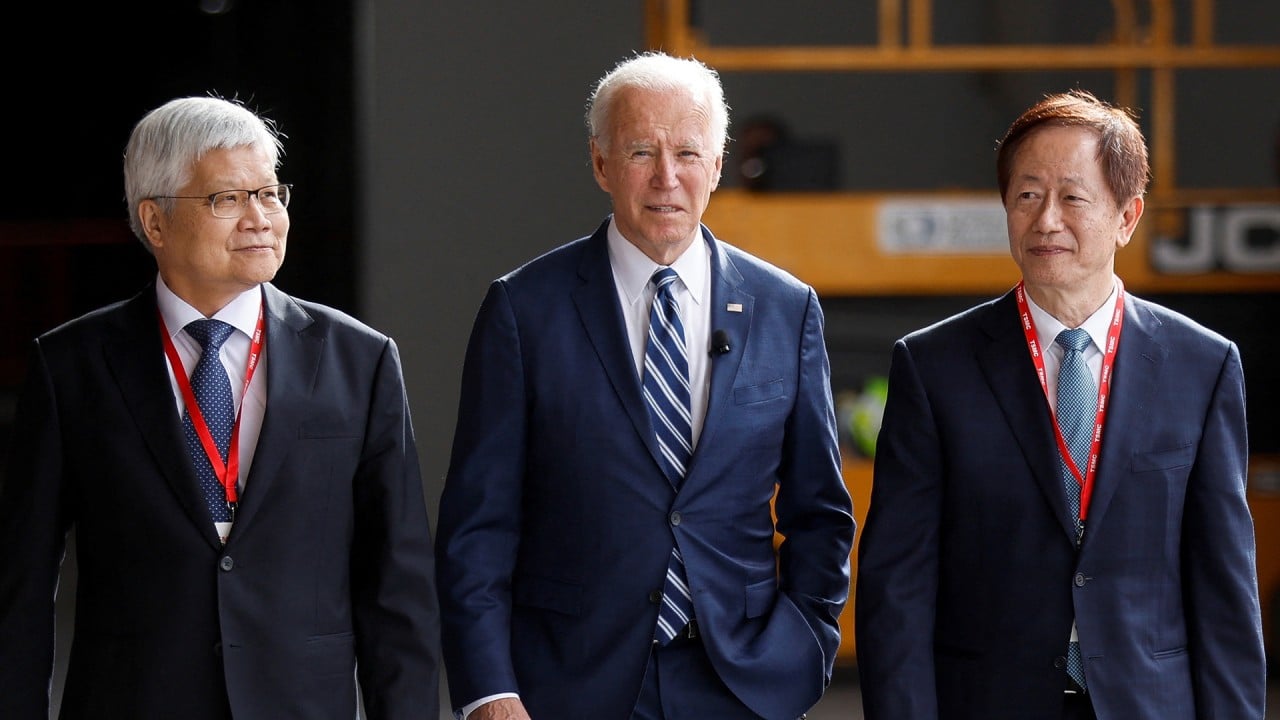
Tech war: starved of chips, China’s bid to topple US as No 1 economy faces ‘unprecedented’ pressure
- US technology containment has led some international organisations to delay – if not drop entirely – forecasts that China will become the world’s No 1 economy
- China’s digital economy accounts for 39.8 per cent of gross domestic product, but for it to power future growth, the country needs high-end semiconductor chips
Semiconductor chips are often compared to the beating heart driving technology innovation. But with the United States restricting exports of critical semiconductor components and technology to China, questions are mounting over how long the world’s second largest economy can maintain a pulse.
Core technologies are China’s Achilles’ heel, despite having the world’s strongest industrial manufacturing capability, and they are easy prey for Washington in its strategy of tech containment.
Without mastery of the fiendishly complex chips that power everything from cars to smartphones, President Xi Jinping’s hopes of transforming China into the pre-eminent global digital power, while surpassing the US to become the No 1 economy in the world, could fall apart.
“Chips are the foundation of the modern economy,” said Jun Zhang, an associate professor of economic geography at the University of Toronto. “There’s a rough estimate that a yuan worth of chips can support 10 yuan worth of electrical capacity and generate 100 yuan’s economic output.”
China faces “unprecedented” pressure from the US and its international competitiveness depends to some extent on how far American containment will go, Zhang said.
Goldman Sachs forecast in November last year there could be a 0.26 percentage point hit to the Chinese economy in 2023 as a result of US containment efforts. The pressure campaign would cause gross domestic product (GDP) to fall by 1.7 percentage points in the medium term, or lead to an annualised drag on growth of about 0.4 percentage points over the next four years.
“We assume the short-term impact comes primarily from the semiconductor and computer sectors, with a small impact from specialised equipment,” the investment bank wrote. “Over a longer horizon, if sustained, the US export controls could have a larger impact.”
Who will take on China’s biggest economic challenges?
China sees the digital economy, which accounts for 39.8 per cent of its GDP, as the country’s major engine of growth. But to reach its potential, the country needs semiconductor chips.
Below the surface, a string of industries – from driverless cars to high-speed computing to artificial intelligence – are already feeling the pain, and the economic toll is only likely to grow.
“Virtually every hardware company in China must deal with the fallout from the sweeping restrictions announced by the US,” said Dan Wang, an analyst with Gavekal Dragonomics.
“These sanctions will hobble China’s semiconductor advances,” he wrote in a report, Eight questions for China’s Tech Sector in 2023, published last month.
When Joe Biden entered office in January 2021, hopes stirred of rapprochement with China, but the new president quickly doubled down on tech containment.
These [chip] restrictions have potentially substantial costs
“This is a sectoral shock, in the short-term primarily, although the sector of course has complex linkages throughout the economy,” Thomas Helbling, deputy director for the International Monetary Fund’s Asia and Pacific department, told a media briefing last week.
The Washington-based organisation has long warned about technological decoupling, supply chain disruption and the geoeconomic fragmentation, saying it could lead to losses of about 5 per cent of global GDP.
“These [chip] restrictions have potentially substantial costs,” Helbling said.
The race for semiconductor supremacy, driven more by political motivations than economic considerations, threatens to not only divert industrial development, but reshape the dynamics of economic growth in the US, China and EU, analysts said.
Beijing has made no official estimate for potential economic losses, but it has criticised Washington for misusing its market dominance and ramped up rhetoric about technology independence.
Xi has identified high-end chips, industrial machine tools, basic electrical devices, hardware, materials, as well as software and algorithms as prominent bottlenecks.
China has set a goal of raising its chip self-sufficiency ratio to 70 per cent by 2025, from around 30 per cent in 2019.
Following the most recent US sanctions, China’s 24-member Politburo convened a closed-door meeting in late January, where they discussed how to improve technology self-reliance, according to the official Xinhua News Agency.
The silver lining for China’s digital economy is that, with the blessing of Communist Party’s top leadership, greater financing and resources will be available to accelerate domestic substitution.
Beijing has launched a new whole-nation mechanism to reach its technology goals, mobilising government funding, entrepreneurship and talent.
How is China rebuilding supply chains abroad after 3 years of isolation?
While state-owned enterprises are encouraged to be the leader in their respective industrial chains, open competition is planned to select top scientists and entrepreneurs.
The Chinese Academy of Sciences started a campaign in 2019 focused on development of mask aligner systems, which are used in semiconductor manufacturing, and high-end chips. More than a dozen prestigious universities, including Peking University and Tsinghua University, have since set up faculties specialising in the development and research of integrated circuits.
China’s R&D expenditure and intensity are fast approaching the US. Expenditure rose 10.4 per cent year on year to a record high of 3.09 trillion yuan (US$455 billion) in 2022, roughly 2.55 per cent of national GDP.
Although an ecosystem of semiconductor materials, parts and equipment has been quickly formed, domestic chip makers lag far behind global players.
“The global semiconductor supply chain is centred on American companies and China’s influence is relatively weak,” said Hyung-Gon Jeong, a senior research fellow at the Korea Institute for International Economic Policy.
“The Chinese economy is expected to be significantly negatively affected if such multinational companies leave China one by one due to US sanctions.”
Many foreign companies have moved production facilities from China, either to cut costs or over political issues, which has forced Chinese authorities to pledge wider market access and a better business environment to keep them onshore.
“Semiconductor chips should be a globalised product. It is against the law of the market to have a complete set of upstream and downstream industries in a single country,” said a senior engineer at a foreign-funded semiconductor plant.
“As a matter of fact, many foreign-funded companies have turned their Chinese ventures into a cost centre, marketing entity or small teams focusing on peripheral research.
“It’s not in line with market rules for chipmaking plants to be relocated to the United States or other countries – it’s largely a political decision.”
It now seems that independent innovation is a pretty long way off
Despite Beijing’s policy incentives and huge spending, the engineer expressed concern that the sector would not be able to lure world-class talent, which was vital, and that some government funding was being wasted on low-value added processes and unfinished projects.
Dozens of chip projects have been launched in recent years. However, some, such as GlobalFoundries’ fab in southwestern city of Chengdu, have been abandoned.
“There are lots of investors who wish to cash in on the government campaign,” the engineer said.
About 46 semiconductor firms took part in the government fast track to raise funds through initial public offerings in Shanghai or Shenzhen last year, with a total capitalisation of more than 700 billion yuan. Another 59 are queuing up to go public, with a planned fundraising size of over 120 billion yuan.
Zhang, of the University of Toronto, said that China needs talent and consistent financial input for long-term innovation.
“There’s no shortcut for technological advancement,” he said. “It now seems that independent innovation is a pretty long way off.”





